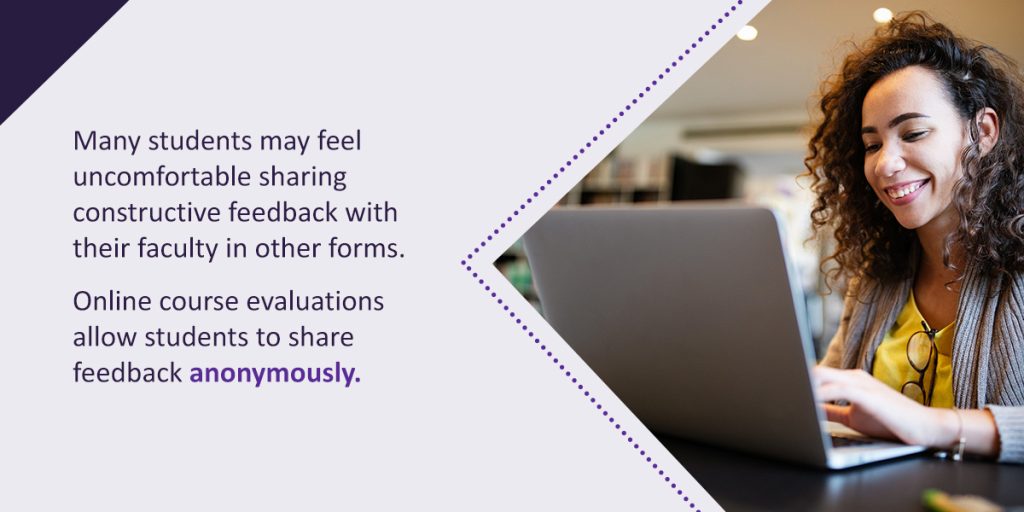




Course evaluations gather feedback from students regarding courses. In them, students may provide feedback about faculty, course content, materials, policies, structure, and more.
The importance of course evaluations lies in faculty members at the institutional level being able to leverage student responses to improve the quality of their course offerings. Traditionally, course evaluations were collected on paper, though technology allows institutions to use online evaluations. Online evaluations present a unique design approach that pushes for student-centered learning while helping instructors focus on the most effective methods of connecting students with engagement opportunities, activities, and content.
Institutions enjoy many benefits when transitioning to an online course evaluation system. Instead of having students fill out paper-based course evaluations, consider the benefits of online course feedback.
One of the most significant benefits of online course evaluations is their ability to convey nuanced remarks from students to faculty. When given more freedom to respond openly and confidentially, students may point out vital considerations to influence policy changes down the road.
Faculty members can take students’ suggestions and feedback to implement positive changes for the next time the course is taught. Improving course quality helps enhance student learning outcomes and overall course satisfaction.
Many students may feel uncomfortable sharing constructive feedback with their faculty. Online course evaluations allow students to do so anonymously, increasing their comfort to share more concrete feedback. This factor increases the likelihood that more students will complete the evaluations. The more responses you get, the more valuable the insights.

Institutions can use feedback provided in course evaluations to evaluate faculty for promotions or tenure. Department chairs may also use course evaluation feedback to help in decision-making when planning which faculty members will teach which courses in upcoming semesters.
Some institutions publish course evaluation reports to share with current and future students. Students can use the information from the evaluations to learn more about a course or professor to help them decide if they want to take it. For example, students may use previous course evaluations to determine the difficulty of a course, what types of projects to expect, or how a faculty member conducts the class.
Printing thousands of course evaluation surveys can get expensive. Online course evaluations help you save money by reducing paper costs. Additionally, online evaluations reduce paper use altogether, contributing to your institution’s image of being green.
You can deliver information quicker using online course evaluations. Online course evaluation software immediately collects data and compiles it into your reports. Department chairs and faculty members will have much quicker access to their evaluations, allowing for faster feedback implementation and improvement.
So, how can you use evaluations for online courses to improve course quality? While each institution has its own way of evaluating courses, here are a few considerations to help make your course evaluations as effective as possible.
To get the most valuable responses, include rating-scale and open-response online course evaluation questions. For example, include 10-20 general rating-scale questions that are standard for every course. Keep the scale simple — a five-point scale is common, and including a “not applicable” or “not sure” option is best.
At the end, include a few written response questions for students to expand on what they did or didn’t like about the course. This is also where faculty members may add their own evaluation questions specific to their courses. For example, a professor may ask for feedback regarding how they conducted a specific aspect of the course.
Course evaluations are typically sent out at the end of a semester within the last week or two of classes. This gives students the most comprehensive view of the course so they can provide feedback on all aspects. To ensure you get the most student responses possible, provide class time for students to complete course evaluations or offer a few extra credit points as an incentive for students who complete the evaluation.
Below are tips for using online course evaluations to bolster student learning outcomes.
Advances in technology make it possible to obtain valuable data via course evaluations to meet various needs at the institutional level.
At Watermark, our Faculty Success (formerly Digital Measures) and Course Evaluations & Surveys (formerly EvaluationKIT) assist faculty efforts to improve instructional quality continuously. See for yourself how Baylor University and other institutions have found success using Watermark solutions.
Watermark’s solutions help you gather and share insights from your institution’s data when it’s time for collaboration across campus in assessment planning, curriculum strategy, annual reviews, or accreditation reporting. Our tools allow you to glean insights from data to make campus-wide decisions that impact your students’ success. Our Course Evaluations & Surveys and Faculty Success can help institutions assess faculty and collect data based on student evaluations.































































































































































































































































































































































































Submit this form to schedule a meeting with one of our reps to learn more about our solutions. If you need customer support instead, click here.